Lunch with Lynne: The Torta de Santuario and Salsa de Plaza
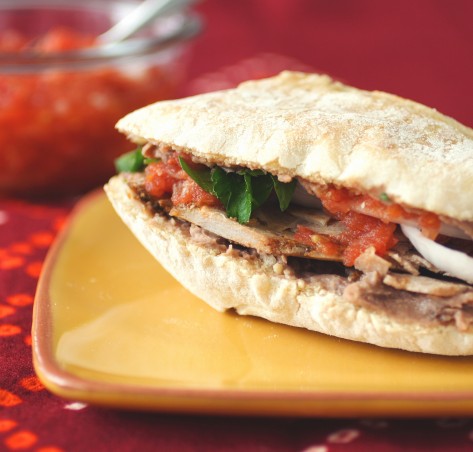
This posting is for Robert Feugate, a sandwich lover and wiz-bang coder and problem solver who helped with some of the behind-the-scenes structural features of the DCCC blog. The Torta de Santuario, or “Santuary Roll,” from The Art of Mexican Cooking may not be what he had in mind when he asked me to write about a sandwich. It’s rather involved. But for hardcore sandwich lovers, for whom making the Vietnamese Banh Mi or the New Orleans Muffuletta from scratch is enjoyable way to spend an afternoon, this multi-step Mexican sandwich will be a feather in their cap.
Here are the components:
1. 1 telera (a Mexican sandwich roll), halved and some of the crumb removed to give more space for the fillings
2. Some refried beans (frijoles refritos) spread on the cut surfaces of the roll
3. Several thinly sliced pieces of seasoned pork loin, Jalisco-style (Lomo Adobado Estilo Jaliso)
4. A layer of shredded lettuce
5. A thin layer of thinly sliced radishes
6. A few slices of white onion, wilted in salted water for 1 hour
7. A nice amount of the delicious salsa de plaza (recipe follows)
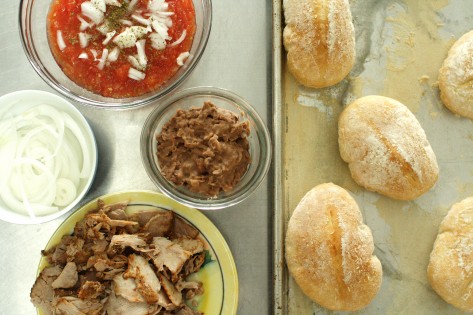
There’s a lot of cross-referencing to make this sandwich! (Recipes for each of the components, including the teleras, can be found in The Art of Mexican Cooking.) The time needed to prepare the sandwich will be cut down considerably if you purchase teleras from a Mexican bakery or market or use Diana Kennedy’s suggested substitution: a hollowed-out baguette. I made the teleras from scratch, in part because I don’t live near a Mexican market and as an excuse to solicit the help of my friend, the never-waning Lynne, to help me form the rolls.
Even when buying teleras or using baguettes, there is still a fair amount of steps: you must cook the beans (frijoles) and then fry them; you must marinate the pork and then cook it; you must make the salsa de plaza; and you must prepare the lettuce, radish and onion toppings. At the end of the day, because I was so focused (perhaps overcomeis a better word) on making all of the various sub-recipes, I forgot to double-check the main recipe list for all of garnishes needed to complete the assembly of the Torta de Santuario. I didn’t have radish or shredded lettuce, and so I substituted some fresh parsley for color. If you think you’re likely to be a little nerve-wracked by bread baking, as I tend to be, go for premade bread: you’ll probably be less likely to forget one of the garnishes. (If you plan to make the teleras, see the photographic how-to at the end of this posting.)
Though missing the crunch and flavor of the radish and lettuce, the sandwich was quite good, but my favorite part was the Salsa De Plaza. It was worth making this involved sandwich just to discover this delicious salsa. Made with fresh tomatoes, vinegar, sugar, serrano chile, and, the secret ingredient, liquid from canned jalapeños en escabeche, which are whole jalapenos pickled in an oil and vinegar brine with spices and sliced carrots, it has the perfect balance of subtle chile heat, a touch of sweetness, and flavor-enhancing acidity. If you don’t live near a Mexican market, it is worth ordering these pickled jalapeños online (I ordered mine from MexGrocer.com) or making them (there is a recipe for them in The Art of Mexican Cooking) just for this salsa.
Salsa De Plaza
(from The Art of Mexican Cooking by Diana Kennedy)
In the introduction to her recipe for Salsa De Plaza, Diana Kennedy stresses the importance of using good, fresh tomatoes. In lieu of garden-ripe summer tomatoes, I used “ripened-on-the-vine” tomatoes from the specialty foods market in my town and let them further ripen and soften on the counter for a few days. And I added a smidgen of tomato paste (and little water) to heighten the tomato flavor.
Diana Kennedy writes that this salsa is typically used as condiment for tortas (sandwiches) and antojitos (a category of Mexican snacks—some think of them as Mexican “tapas”—typically sold from push-carts that includes familiar items like tacos, enchiladas, tostadas, quesadillas). I like it so well I’ve made it a staple salsa for serving with chips.
This salsa should be eaten fresh or within a few days.
Makes about 2¼ cups
1 pound ripe tomatoes
1 small white onion, sliced
1 serrano chile, roughly chopped
1 teaspoon sugar
1 teaspoon sea salt
1 tablespoon strong vinegar (I suggest using white or white wine vinegar of 5 or 6% acidity)
2 tablespoons liquid from canned jalapeños en escabeche
The Topping
⅓ cup finely chopped white onion
½ teaspoon Mexican dried oregano
Place the tomatoes in a pan and cover with water. Bring to a rapid simmer and cook for 5 minutes. Drain the tomatoes and transfer, with peels on, to a blender jar. Add the onion, serrano chile, sugar, salt, vinegar, and liquid from the chile can and blend until almost smooth. Transfer the salsa to a serving bowl and sprinkle with the onion and oregano. Serve with an appropriate Mexican food—a torta or antojitos—or simply with chips.
Lynne Forms Teleras and Assembles the Torta
To make the teleras (flat bread rolls) for the Torta de Santuario, follow the recipe for making bolillos (bobbin-shaped bread rolls) in The Art of Mexican Cooking through the point of forming the dough for bolillos into twenty-four balls, after which you form the dough into the final shape for teleras, let them proof, and then bake. (Diana Kennedy’s recipe for teleras instructs the baker to follow the recipe for bolillos up to the point of cutting the dough into twenty-four pieces, but I found this confusing and assumed this to be a mistake. If anyone has made this recipe, and has also found this instruction confusing, please let me know how you proceeded with the recipe and what results you had.)
I found the directions lacking in detail, especially for someone who has no intuitive sense about bread baking, so I may have had beginner’s luck. I modified the recipe slightly by using about half the amount of salt called for in the bolillos starter. (Salt retards the activity of yeast. My first attempt at the starter didn’t rise in the least—thus the modification.) The photos pick up at the point of forming the dough into the final teleras shape.
1. Flatten each ball of dough into an oval using a rolling pin or your hands. Diana Kennedy didn’t specify either the thinness or dimensions of the oval. I assumed that they are meant to be rolled quite thin (and large) because they’re meant to be a sandwich roll.
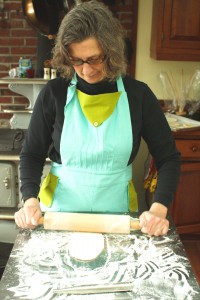
2. Press down firmly in the middle of the dough to form a groove (or you can make two indentations), until you think the dough will sever. (Diana Kennedy doesn’t specify what to use to create the groove; we used a turkey baster because it seemed about the right dimension.)

3. Gently shake the dough to remove excess flour.
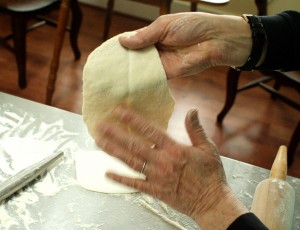
4. Place the dough upside down on a greased and floured baking sheet.

5. Let rest, uncovered, in a warm place (about 70°F), for about 1 hour. The dough should double in size, as shown here. (This final rise of the dough in its final shape is called proofing.) Flip the teleras over and bake for 15 to 20 minutes in a 400°F oven. (They are done when they are golden in color and sound hollow when tapped on the bottom.)
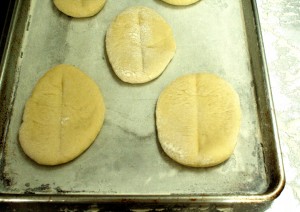
Tip: After the teleras have proofed, remember to flip them before popping them in the oven so that the moist side is facing up. I forgot to do this final step with one tray of rolls and they didn’t poof up like the others. It’s simply too hard for yeast to give us their final burst of activity in the hot oven—called “oven spring”—when they have to push up against dough that’s become dry after proofing uncovered for an hour.
6. Assemble the sandwich.

7. And enjoy . . .


Yum! That was good!
1